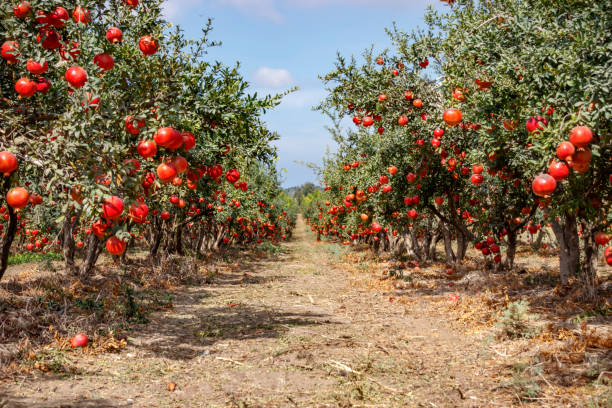Pomegranate farming is gradually gaining attention in Kenya, a country with a rich agricultural heritage that continues to explore new crops with both nutritional and economic value. Pomegranate, also known locally as Kukumanga, is an exotic fruit that has captured the interest of a select group of farmers, despite its current limited production. This fruit, with its vibrant red color and a host of health benefits, could be a game-changer for farmers seeking new income sources.
In this article, we will explore the numerous advantages of cultivating pomegranates in Kenya, including its nutritional benefits, the best regions for growth, the varieties that thrive in the Kenyan climate, and how farmers can successfully venture into pomegranate farming.
The Nutritional Value of Pomegranate
Pomegranate is a fruit that packs a powerful nutritional punch, making it a highly valued commodity. Here are some of the key health benefits of Kukumanga:
- Rich in Fiber: Pomegranate is an excellent source of dietary fiber, which aids in digestion and promotes gut health. This helps prevent constipation and encourages a healthy digestive system.
- Boosts Blood Circulation: The high nitrate content in pomegranates helps improve blood flow, which in turn supports heart health and reduces the risk of cardiovascular diseases.
- Anti-Inflammatory Properties: The antioxidants in pomegranate, including polyphenols, contribute to reducing inflammation in the body, which can help alleviate symptoms of chronic conditions like arthritis.
- Cancer Prevention: Pomegranates contain flavonoids, which are known to counteract cancer-causing cells, making them a useful part of an anti-cancer diet.
- Oral Health: Pomegranate’s antibacterial properties can help reduce dental plaque and gum disease, contributing to improved oral hygiene.
- High in Vitamins: Pomegranates are rich in essential vitamins such as Vitamin C, which boosts immunity, and Vitamin K, which supports bone health.
With such impressive health benefits, it’s no surprise that the demand for pomegranates is growing both locally and internationally. This is especially true given that they are commonly used in cosmetics and beauty products, a market that continues to expand.
Ideal Growing Areas for Pomegranate in Kenya
Pomegranate is a highly adaptable plant that thrives in arid and semi-arid regions. This makes it an ideal crop for Kenya’s climate, especially in areas that suffer from unreliable rainfall or extended dry periods. The fruit is drought-tolerant and can flourish in regions where other crops may struggle.
Some of the most suitable regions for growing pomegranates in Kenya include:
- Makueni: Known for its dry conditions, Makueni provides an excellent environment for pomegranate cultivation.
- Machakos: This county has the ideal altitude and temperature for pomegranate farming.
- Kitui: Pomegranate farming is gradually being adopted in this region, especially in areas where water scarcity is common.
- Parts of North Eastern Kenya: Regions like Garissa and Wajir have climates conducive to pomegranate growth.
- Nyeri: Though a high-altitude area, Nyeri’s temperature and soil type make it suitable for growing certain varieties of pomegranate.
- Kisumu and parts of Western Kenya: Pomegranate farming is expanding in these areas, with farmers embracing the opportunity to diversify their agricultural activities.
- Coastal Region: Given its relatively dry conditions, parts of the coastal region, such as Kwale and Kilifi, are excellent for growing pomegranates.
Ecological Conditions for Growing Pomegranates
For optimal growth, pomegranates require specific ecological conditions. Understanding these conditions is crucial for farmers looking to maximize their yield. Here are the key factors to consider:
- Temperature: Pomegranate plants thrive in temperatures ranging from 20°C to 30°C. However, for the flowering, fruit development, and ripening stages, a slightly warmer temperature range of 35°C to 38°C is optimal.
- Altitude: Pomegranates grow best at altitudes between 500 to 1000 meters above sea level. These conditions are found in many parts of Kenya.
- Soil: Pomegranate trees require well-drained soil with a pH level between 6.5 and 7.5. The best soil for growing pomegranates is deep loamy soil, which ensures proper root growth and water drainage.
- Rainfall: Pomegranates are drought-tolerant and require very little rainfall. They can withstand extended dry periods, making them ideal for regions with low annual rainfall.
Popular Varieties of Pomegranate in Kenya
Kenya has seen a growing interest in cultivating various pomegranate varieties, each with its distinct characteristics. Here are the most commonly grown pomegranate varieties in Kenya:
- Bhagwa: This variety is known for its large, juicy fruits and high-quality seeds. It is popular for both fresh consumption and juice production.
- Jalore Seedless: As the name suggests, this variety is seedless, which makes it easier to consume and sell as a fresh fruit. It is also a popular choice for juicing.
- Kandhari: Known for its hardiness and drought resistance, this variety is often chosen by farmers in arid and semi-arid regions.
- Ganesh: This variety is prized for its sweet flavor and high yield. It is also resistant to certain pests and diseases, making it a farmer favorite.
- Jyothi: Jyothi pomegranates are known for their beautiful red color and rich taste. They are favored in both local and international markets.
- Mradula: This variety is high in antioxidants and is sought after for its health benefits.
- Phole Arakta: This is another variety grown for both its aesthetic appeal and nutritional value.
How to Propagate Pomegranates
Pomegranate is usually propagated through stem cuttings, which can easily be taken from healthy, mature plants. The recommended spacing for planting pomegranates is approximately 3.5 meters by 4 meters, which ensures that each plant has enough space to grow and produce fruit. With this spacing, about 200 plants can be grown per acre.
While pomegranate trees are relatively low-maintenance, they do require significant attention, particularly when it comes to weed control. Weeding is essential for healthy growth, and methods such as mulching and planting cover crops can help manage weeds. Intercropping with crops such as legumes is also an option for farmers looking to maximize land usage.
Pomegranate Harvesting and Yield
Pomegranate trees usually take 3 to 5 years to start bearing fruit, but once established, they can yield a substantial amount of produce. Harvesting should take place approximately 5 to 6 months after flowering. The fruit is typically harvested when it reaches a deep red color and feels heavy for its size.
Farmers can expect to harvest pomegranates annually, and the trees will continue to produce fruit for many years, with some trees reaching 15 to 20 years of productive life.
Market Opportunities for Pomegranate in Kenya
While pomegranate farming is still a niche venture in Kenya, the fruit has significant market potential. The fruit is in demand for its nutritional benefits and is also used in the production of cosmetics, juice, and beauty products.
Currently, much of the pomegranate used in Kenya is imported. However, there is a growing local market for the fruit, particularly in urban centers such as Nairobi, where consumers are becoming more health-conscious and interested in exotic fruits. One pomegranate can retail at Ksh. 150 to Ksh. 300, depending on its size and quality.
Additionally, pomegranate farming offers farmers an opportunity to tap into the lucrative export market. There is growing demand for pomegranates in international markets, particularly in the Middle East, Europe, and parts of Asia. Exporting pomegranates can provide Kenyan farmers with access to higher-value markets, thus improving their income.
Costs and Returns of Pomegranate Farming
The cost of starting pomegranate farming can vary depending on factors such as land size, water access, and the variety of pomegranate being cultivated. Seedlings are typically sold for Ksh. 300 each, and the initial investment for an acre of land can range between Ksh. 30,000 to Ksh. 50,000. However, given the fruit’s relatively low maintenance and the potential for high returns, pomegranate farming can be a lucrative venture.
Farmers can expect to start seeing returns on their investment in the second to third year of cultivation. Once mature, a single pomegranate tree can yield up to 100 fruits annually, with an average selling price of Ksh. 150 to Ksh. 300 per fruit.
The Future of Pomegranate Farming in Kenya
Pomegranate farming in Kenya holds tremendous potential, especially for farmers in arid and semi-arid regions. The fruit’s nutritional benefits, drought tolerance, and growing demand both locally and internationally make it an attractive option for those looking to diversify their agricultural activities.
With proper management, pomegranate farming can be a rewarding venture, offering high returns and contributing to sustainable agricultural practices. As the Kenyan market becomes more health-conscious and consumers seek out natural, nutrient-rich products, pomegranate farming is poised to become an essential part of Kenya’s agricultural landscape.





